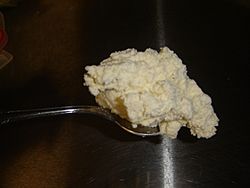Rigouta facts for kids
Quick facts for kids Rigouta |
|
|---|---|
 |
|
| Country of origin | Tunisia |
| Source of milk | Sheep |
| Texture | fresh soft |
| Aging time | 1 week |
| Named after | Lua error in Module:Wikidata at line 70: attempt to index field 'wikibase' (a nil value). |
Rigouta is a special kind of fresh, soft cheese from Tunisia, a country in North Africa. It's mostly made in the city of Béja. This cheese is quite similar to the Italian cheese called ricotta. It's made from the liquid left over after making other cheeses, which is called whey. This particular whey comes from a type of sheep known as Sicilo-Sarda sheep.
Contents
How Rigouta is Made
Making Rigouta is an interesting process that uses the liquid part of milk.
From Whey to Cheese
First, the whey is heated up to a very warm temperature, usually between 80 and 90 degrees Celsius (that's about 176 to 194 degrees Fahrenheit). This heating makes tiny bits of protein in the whey clump together. Think of it like how egg whites get solid when you cook them.
Draining the Cheese
Once the proteins have clumped, the mixture is carefully poured into special containers. These can be small baskets made of straw, a clean cloth, or even plastic or metal containers with tiny holes. This step lets the extra liquid drain away, leaving behind the soft, fresh cheese.
Tiny Helpers: Microbes
Did you know tiny living things help make cheese? For Rigouta, special micro-organisms (which are very, very small living things, like bacteria) help with a process called fermentation. These tiny helpers change the whey in a good way, giving the cheese its unique taste and texture. The main ones involved are Lactococcus lactis and Enterococcus faecalis.
Rigouta in Tunisian Cooking
Rigouta isn't just eaten on its own. It's also a popular ingredient in many yummy dishes from Tunisian cuisine. People use it as a base for different foods, adding its creamy, fresh taste to meals.

